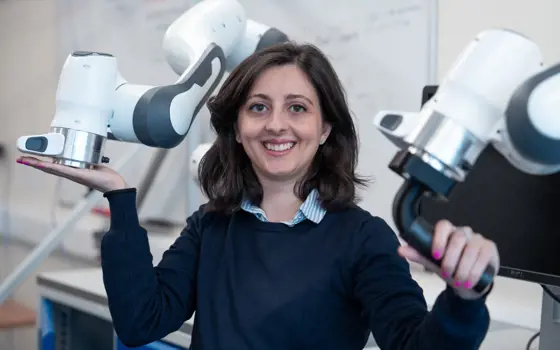Home
Top stories
Quick read

- Aerospace
- Innovation Watch
Invention based on household objects could help us extract water from frozen moon soil
If we want to pursue more ambitious deep space missions, it’ll help to have a lunar base with a clean water supply. Now, Gloucestershire-based startup Naicker Scientific has invented a way to purify water from icy lunar soil based on a Tesco microwave and ultrasound technology.
Quick read

- Health & medical
- Technology & robotics
- Innovation Watch
Next-generation chips could shrink neural implants, reducing need for surgery
Neural implants can be hugely effective for treating conditions such as Parkinson’s and epilepsy. But most require major surgery. Imperial College London spinout MintNeuro is developing the electronic circuitry that will unlock tiny, minimally invasive brain implants.
Quick read

- Technology & robotics
- Innovation Watch
A sense of touch for extra robotic arms
When you could use a hand, Dr Alessia Noccaro might be able to give you an extra one. A roboticist at the University of Newcastle, Noccaro is studying extra robotic limbs, the best ways to control them without taxing our brains too much, and how we can ‘feel’ what they feel with haptics.
Quick read

- Technology & robotics
- Opinion
Innovation machines: can AI boost human creativity?
AI won’t replace human creativity. But it could become an invaluable creative partner, say Nick Jennings FREng and Lise Jaillant.
Quick read

- Environment & sustainability
- Software & computer science
- Innovation Watch
Better batteries, crunchier biscuits: prize-winning startup Polaron solves material problems
When three Imperial College researchers set out to develop AI tools for making better batteries, they probably didn’t expect that the same tools might one day help fine-tune the texture of Oreos.

- Arts & culture
- Civil & structural
- Issue 100
How ABBA Voyage was made
ABBA said they’d never tour again. Bringing them back required a technological marvel, a fully demountable arena, and an array of engineering disciplines working in tandem to make it all come together. Leonie Mercedes goes on a voyage to explore the engineering behind the show.
Keep up-to-date with Ingenia for free
Subscribe todayEngineering for the planet
Brilliant engineers are at the cutting edge of climate impact, fighting for a greener world every day.

- Environment & sustainability
- Materials
- Issue 102
Concrete foundations for net zero
If concrete were a country, it would be the third largest emitter of CO₂ after the US and China. The race is on to slash its emissions. Swapping out its most polluting ingredients, locking in carbon, and upcycling our industrial and construction waste could hold the key, says Leonie Mercedes.

- Materials
- Environment & sustainability
- Issue 98
Mining volcanoes for metals
Green technologies depend on a range of metals and minerals. With concerns about environmental damage from conventional mining, scientists and engineers are seeking alternative sources. Could metal-rich magmatic brines underneath volcanoes have the answer?

- Environment & sustainability
- Materials
- Issue 102
Taking the heat out of climate change
When we think of storing energy, we usually think of batteries. But with a huge slice of global carbon emissions resulting from producing heat, engineers are developing ways to store this critical resource with the hopes of driving us closer to net zero, writes Stuart Nathan.
People in engineering
Looking for careers inspiration? Say no more.
Quick read

- Sports & leisure
- How I got here
Q&A: Amjad Saeed, master’s student in motorsport engineering
Amjad Saeed is studying for a master’s in motorsports engineering, after winning a Royal Academy of Engineering and Mission 44 MSc Motorsport Scholarship.
Quick read

- Arts & culture
- How I got here
Q&A: The Bakineers
Ingenia spoke to three of the eight (!) engineers who’ve starred in the Great British Bake Off: Andrew Smyth, Giuseppe Dell’Anno, and Dr Rahul Mandal, each of whom are living proof that engineering and baking happily co-exist.
Quick read

- Software & computer science
- How I got here
- Issue 102
Q&A: Sarah Barrington, PhD student studying AI harms and deepfakes
After studying engineering in the UK and embarking on a career in data science, Sarah Barrington is now a PhD student at the University of California, Berkeley.
About Ingenia
We run stories about engineering of all kinds.
Our stories showcase its unique breadth and variety, how it makes a difference, and how it helps to shape an inclusive, equitable, and sustainable future.




